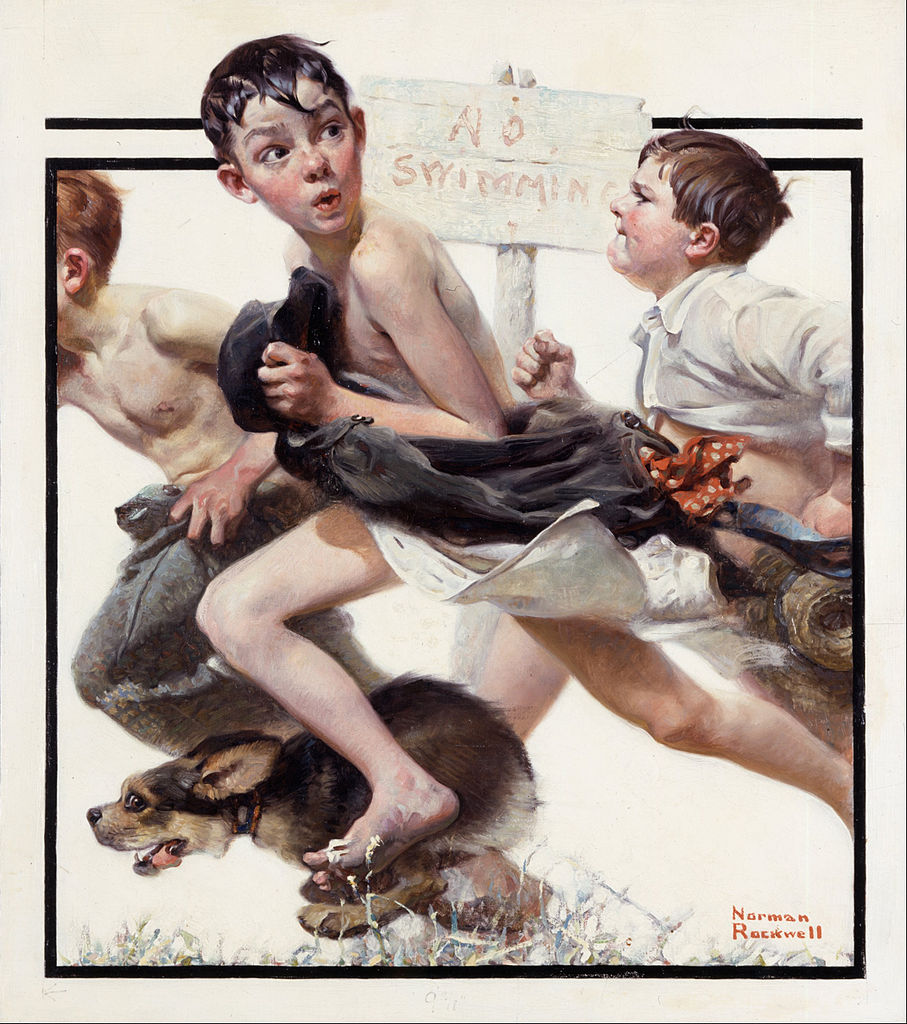BE A MODEL (GRADES K-8)
Build descriptive language skills as you pretend to be Norman Rockwell directing a model.
In paintings like this we can see that Norman Rockwell was really good at capturing the thoughts and feelings of children. To help him do this he had real children pose for his illustrations. Sometimes they had to stand for long periods of time in very uncomfortable poses. Later the job got a little bit easier. Instead of having models pose for hours, Rockwell set up the pose and took a picture that he could refer to later.
GOALS
- Learn about Rockwell’s process through active role-playing.
- Use detail to describe actions, expressions, thoughts, and events.
- Participate in collaborative conversations with diverse partners.
MATERIALS
- A printed or digital copy of “No Swimming” and “Cousin Reginald Spells Peloponnesus” [insert link to images].
- Writing paper
- Drawing materials and drawing paper
- A digital camera (optional)

No Swimming, Norman Rockwell. 1921.
©1921 SEPS: Licensed by Curtis Publishing, Indianapolis, IN

Cousin Reginald Spells Peloponnesus (Spelling Bee) 1918
[One line activity for teaser: Why’d you make that face? Speculate on what Rockwell might have said to get the model to make this expression.]
ACTIVITY
Observe
- Look at the painting together. Draw student’s attention to the boy in the center’s face. Ask:
- What do you notice?
- What do you think the boy is feeling? Why?
- What do you think he sees behind him?
- Now ask students: What do you think Rockwell said to the boy who was modeling for him in order to get him to make that face?
- Write children’s descriptive words on the board.
Explore
- Ask students to pair up. Assign one student the role of model and one the role of Rockwell.
- Show “Rockwell” the painting titled, “Cousin Reginald Spells Peloponnesus.” Do not show the image to the model.
- Explain that Rockwell must try to get the ‘model’ to make the same expression as the boy in the red sweater. Explain that all he can use to do this are words-the more detail the better! Encourage him to experiment with directions like “Make a face like someone just stole your favorite toy.” Or “Scrumple your forehead like you are so mad you might explode.”
- Once the child playing Rockwell is satisfied with the model’s expression, take a digital photo of the model.
- Invite the class to share their photos and compare (if you do not have a digital camera children can demonstrate their poses).
- Ask: How close did the model get? What else might Rockwell have said in order to get the model to match the character in the picture?
- Invite children to switch roles and try the process again.
EXTENSIONS
Try these activities to go even farther with your explorations.
Create
- Have each student use his photo to create a portrait. Then have students write a description of their work.
Reflect
- Divide children into small groups and have them discuss the following questions:
- What was difficult?
- What was fun?
- What might it have been like to actually be a Rockwell model?
- Now have students work as a team to create a “want ad” for a model to be used in a specific Rockwell painting of their choice. What qualities would this model need to have? What should they look like? What age should they be? What should their personality be like?

